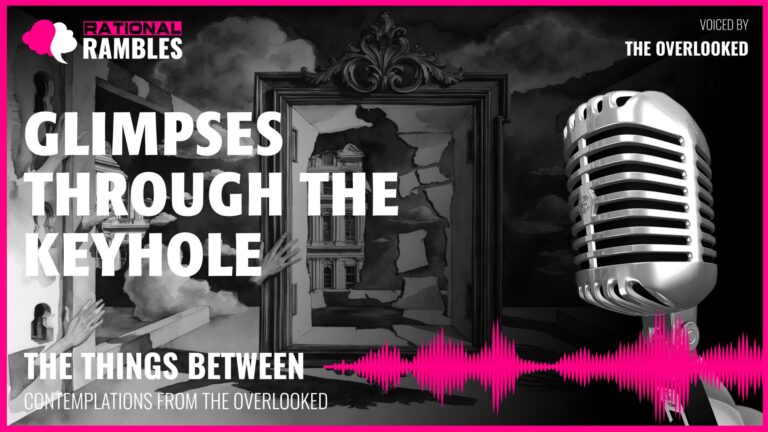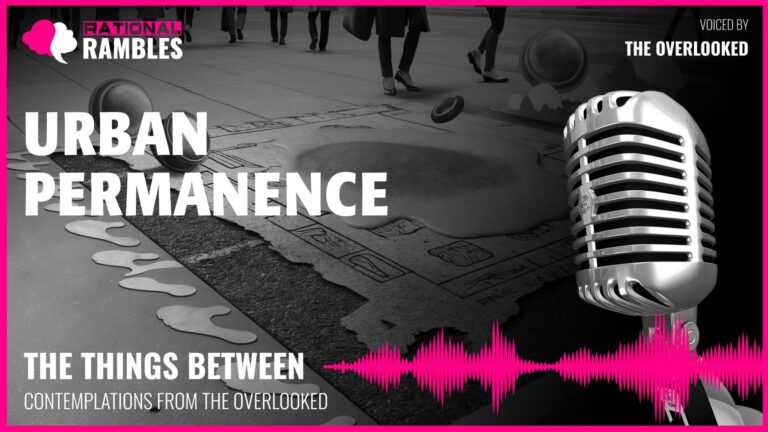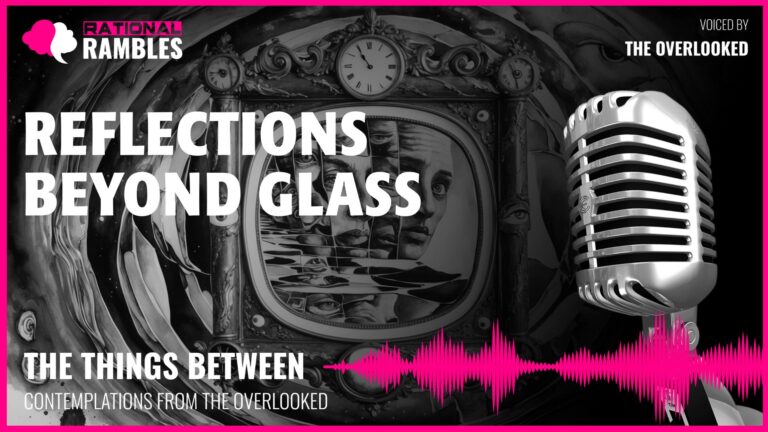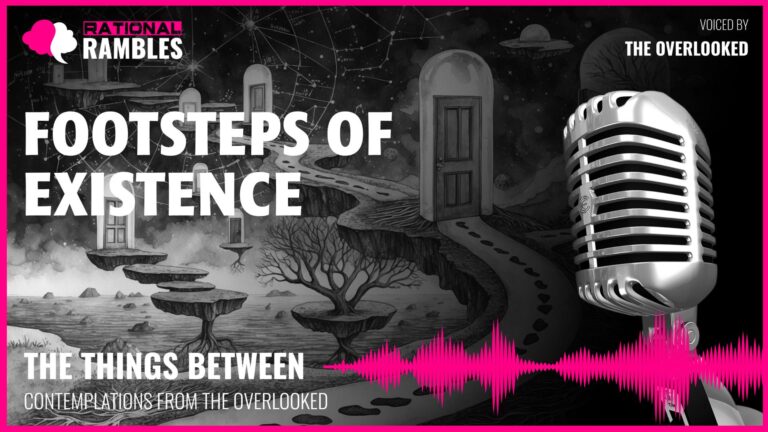The Hidden Architecture of Beauty: Exploring the Unseen Dimensions of Existence
Introduction
What lies behind that which captivates our attention? For every surface that draws our gaze, there exists a hidden dimension—unseen, unacknowledged, yet essential to the very existence of what we admire. Our cultural obsession with facades and presentations often blinds us to the supporting structures that make beauty possible. This philosophical inquiry explores the ontology of the unseen, examining how invisibility shapes existence, how purpose manifests beyond intention, and how meaning arises in the shadows.
Throughout human history, philosophers have grappled with dualities: mind and body, substance and form, appearance and reality. Yet perhaps none is more universally experienced yet less examined than the relationship between what is presented to the world and what remains hidden behind. This relationship transcends mere physical arrangement—it speaks to fundamental questions about identity, purpose, consciousness, and the nature of beauty itself.
As we navigate a world increasingly defined by curated appearances and cultivated personas, there emerges a pressing need to examine the philosophical significance of that which supports from behind—the infrastructure of beauty, the architecture of presentation, the forgotten halves of our existence. What wisdom might we discover by turning our attention to what typically faces the wall?
The Ontology of Invisibility
Invisibility is not the same as non-existence. This crucial distinction forms the foundation of our exploration. The Western philosophical tradition has long privileged the visible—from Plato’s forms illuminated by the light of reason to Enlightenment clarity and transparency. Yet there exists a rich philosophical vein examining that which exists beyond sight.
Consider Heidegger’s concept of “ready-to-hand” tools that disappear from our conscious awareness precisely when functioning properly. The hammer vanishes from our perception during use, becoming an extension of ourselves rather than an object of contemplation. It is only when the hammer breaks—becoming “present-at-hand”—that we notice its existence again. This phenomenological approach suggests that invisibility can be a mark of perfect integration and function, not irrelevance.
The Necessary Unseen
The material world depends upon invisible supporting structures. Buildings stand on foundations buried beneath the ground. Bodies function through unseen cellular processes. Digital experiences rely on hidden code. The visible world is quite literally held aloft by what cannot be seen. This relationship is not incidental but essential—there can be no presentation without support, no display without infrastructure.
Maurice Merleau-Ponty’s exploration of the visible and invisible addresses this interdependence: “The visible is pregnant with the invisible… to see is always to see more than one sees.” This suggests that invisibility is not merely absence but a positive presence that makes the visible possible. When we truly understand an object, we grasp both its apparent features and the hidden dimensions that enable its appearance.
Shadow Consciousness
What kind of consciousness emerges in the shadow? If perception shapes awareness, then experiencing the world from a position of perpetual invisibility must create a distinctive form of being. Unlike the externally-directed consciousness of the visible object—always aware of being perceived—the consciousness of the invisible develops an inward-facing quality, characterized by contemplation rather than presentation.
This shadow consciousness bears similarity to what psychoanalyst Carl Jung termed the “shadow self”—those aspects of our personality that exist but remain unacknowledged. For Jung, psychological wholeness required integration of the shadow, not its elimination. Similarly, a complete philosophical understanding of existence must incorporate both what faces outward and what faces the wall.
The philosopher Emmanuel Levinas argued that true ethical encounters occur in facing the Other—a direct confrontation with another consciousness. What happens, then, to entities perpetually denied this face-to-face encounter? Perhaps they develop a different mode of relation—one based not on mutual recognition but on supporting without expectation of reciprocity. This suggests an ethical dimension to invisibility that transcends conventional understanding.
Dualism and Identity
The relationship between a painting’s face and its back raises profound questions about dualism and identity. Are they one entity or two? This question echoes philosophical debates that have persisted since ancient times—from Plato’s distinction between body and soul to Descartes’ separation of mind and body, and more recent phenomenological attempts to overcome these divisions.
The Paradox of Unified Duality
Unlike Cartesian dualism, which posits two fundamentally different substances (mental and physical), the front and back of an artwork share the same substance yet experience radically different existences. They are materially unified but functionally and experientially distinct. This presents a fascinating paradox: complete inseparability paired with fundamentally different modes of being.
This paradox might be better understood through Spinoza’s concept of modes—the idea that seemingly distinct things can be expressions of a single substance viewed from different perspectives. The front and back are not separate entities but different aspects of the same reality, comprehensible only in relation to each other.
Identity Without Recognition
What constitutes identity when recognition is absent? Traditional philosophical approaches to personal identity often incorporate some element of social recognition—from Hegel’s notion that self-consciousness emerges through recognition by others to contemporary social theories of identity formation. Yet the back of a painting develops identity without the mirror of others’ perception.
This suggests a form of identity constructed not through reflection but through function and relation. Identity emerges not from being seen but from supporting, not from recognition but from necessity. This challenges our conventional understanding of how selfhood develops and persists.
The philosopher Charles Taylor describes identity as oriented toward “frameworks of significance”—the values and meanings that give orientation to our lives. For the unseen support structure, this framework centers on function rather than appearance, on necessity rather than aesthetics. Its significance derives from what it enables rather than what it presents.
The Epistemology of Limited Perception
How does knowledge form under conditions of limited perception? The back of a painting never directly experiences what it supports, knowing the artistry on its other side only through indirect means—overheard conversations, brief glimpses during reframing, vibrations transmitted through the canvas. This raises profound questions about how we know what we cannot directly perceive.
Constructing Reality from Fragments
When direct perception is impossible, knowledge becomes a constructive act—piecing together fragments of information to create a coherent understanding. This process resembles what philosopher Nelson Goodman called “worldmaking”—the idea that we actively construct rather than passively discover the reality we inhabit.
This constructive epistemology challenges the empiricist tradition that privileges direct sensory experience. It suggests that knowledge can emerge from peripheral awareness, from the negative spaces surrounding what can be directly known. The back of a painting constructs its understanding of the artwork it supports through inference, through the collection of traces and secondhand accounts.
The Wisdom of Indirect Knowledge
There may be unique insights available only through indirect perception. Direct observation is often bound up with judgment, with immediate aesthetic and emotional responses that can obscure deeper understanding. The distance of indirect knowledge—like the back of a painting that knows the artwork only through the reactions it produces in others—creates space for a different kind of comprehension.
This parallels Heidegger’s concept of “meditative thinking” as distinct from “calculative thinking.” Where calculative thinking seeks to master what it observes, meditative thinking dwells with phenomena, allowing their meaning to emerge gradually. The limited perception of the painting’s back necessitates this meditative approach—unable to grasp its counterpart directly, it must dwell with partial knowledge, finding meaning in this incompleteness.
Epistemologist Miranda Fricker has explored how social position affects access to knowledge. Her concept of “epistemic injustice” describes how marginalized perspectives are excluded from knowledge production. The back of a painting suffers a kind of epistemic injustice—denied direct access to the very thing to which it is most intimately connected. Yet this position also enables unique epistemic virtues: patience, attention to subtle cues, integration of limited information, and humility about the partiality of all knowledge.
The Philosophy of Support
What does it mean to exist primarily as support for something else? This question touches on fundamental issues of purpose, teleology, and relational being. The back of a painting exists to enable the presentation of its front—its purpose is derived from what it makes possible rather than from intrinsic qualities or intentions.
Relational Ontology
Traditional Western metaphysics has often focused on substances—self-sufficient entities whose existence doesn’t depend on their relations to other things. In contrast, relational ontology proposes that relations are not secondary to pre-existing entities but constitutive of them. Things exist not as isolated substances but as nodes in networks of relationships.
The back of a painting exemplifies this relational existence. Its being is defined by its relationship to what it supports. This echoes Martin Buber’s distinction between “I-It” and “I-Thou” relations—whereas the front of the painting may exist in an “I-It” relationship with viewers (as an object of appreciation), the back exists in something closer to an “I-Thou” relationship with the front, characterized by mutual dependence rather than objectification.
The Ethics of Supporting Roles
Is there an ethics specific to supporting roles? Contemporary ethical frameworks often emphasize agency, autonomy, and visible impact. Yet there may be a distinct ethical dimension to existing as support—a virtue ethics of enabling rather than acting.
Feminist philosopher Nel Noddings develops an ethics of care that privileges sustaining relationships over individual achievement. Similarly, the ethics of support suggests that enabling others’ flourishing constitutes a meaningful moral position. The back of a painting practices this ethics perfectly—it literally holds up the artwork, making its beauty and meaning possible without demanding recognition.
This ethics of support challenges conventional understandings of purpose and flourishing. Success is measured not by individual achievement but by how well one enables others to achieve. Fulfillment comes not from recognition but from necessity—from knowing that what one supports could not exist without one’s presence.
Finding Dignity in Necessity
There is a distinct dignity in being valued for function rather than appearance. When a conservator examines the back of a painting, they attend to its structural integrity, its tensile strength, its ability to fulfill its supporting role. This assessment recognizes a different kind of value than aesthetic appreciation—a value based on reliability, durability, and essential function.
Immanuel Kant distinguished between “dignity” and “price”—where things with price can be replaced by something else of equal value, those with dignity are irreplaceable. The back of a particular painting is irreplaceable; no other structure could support exactly that artwork in exactly the same way. This irreplaceability confers dignity despite invisibility.
Albert Borgmann’s concept of “focal practices” distinguishes between devices (which make things available without engagement) and things (which require our attention and involvement). Supporting structures like the back of a painting are quintessential “things” in Borgmann’s sense—their function emerges through active engagement with what they support, not through passive availability.
Aesthetic Theory and the Unseen
Can there be an aesthetics of the unseen? Traditional aesthetic theory focuses on what is visible, audible, or otherwise perceptible. Yet the question of whether beauty can exist without being witnessed raises profound questions about the nature of aesthetic experience.
Beauty Beyond Perception
If a painting falls in a closed gallery, and no one is there to see it, does it still contain beauty? This version of the philosophical thought experiment about the tree falling in the forest addresses fundamental questions about the ontology of aesthetic qualities. Is beauty inherent in objects or constructed through perception?
The philosopher George Santayana defined beauty as “pleasure objectified”—suggesting that beauty requires a perceiver who experiences pleasure. Yet other traditions, particularly Platonic ones, regard beauty as an objective quality that exists independently of perception. In this view, the back of a painting could possess beauty even if no one ever sees it—beauty as an inherent rather than relational property.
John Dewey’s pragmatist aesthetics offers a middle path. For Dewey, aesthetic experience emerges from the interaction between perceiver and perceived. Beauty is neither purely subjective nor purely objective but exists in the relationship between the two. This suggests that while the unseen back of a painting might not participate in conventional aesthetic experience, it could participate in a different kind of aesthetic relation—one based on function, support, and enabling rather than visual appreciation.
The Aesthetics of Utility
There exists an aesthetic tradition that finds beauty in purely functional objects—from Japanese tools to Shaker furniture. This “aesthetics of utility” values objects for how perfectly they fulfill their purpose rather than for decorative elements. The back of a painting, in its unadorned functionality, exemplifies this aesthetic principle.
Architect Louis Sullivan’s famous principle that “form follows function” suggests that true beauty emerges from perfect adaptation to purpose rather than from superfluous ornamentation. The back of a painting, with its stretched canvas and supportive frame, represents function in its purest form. Its beauty lies precisely in how perfectly it fulfills its supporting role—a different kind of beauty than the intentional aesthetics of the front, but beauty nonetheless.
Accidental Art
The back of a painting accumulates marks that were never intended as art—gallery labels, penciled notations, staple marks from previous framings. These accidental markings create an unintentional composition with its own aesthetic qualities. This suggests an aesthetics of the incidental—beauty that emerges without design, through the accumulation of traces left by time and use.
This connects to broader philosophical questions about intention and meaning in art. While traditional aesthetics often privileges the artist’s intention, contemporary theory recognizes that meaning emerges through context, history, and reception as much as through original intent. The accidental composition on a painting’s back represents meaning beyond intention—a record of the artwork’s journey through time and space, creating significance never planned by any creator.
Time, Change, and History
How does time manifest differently for the seen and the unseen? The back of a painting experiences time in a distinctive way—its aging is unobserved, its deterioration private, its history recorded in physical traces rather than in the social memory of viewers.
Unwitnessed Deterioration
Physical objects change over time whether observed or not. The back of a painting yellows, its wood frame subtly shifts with humidity and temperature changes, its canvas gradually loosens or tightens. These changes occur without observation—a process of aging without audience.
This unwitnessed deterioration raises questions about the relationship between perception and temporal change. Does change have different significance when unobserved? The philosopher Henri Bergson distinguished between measured time (temps) and lived duration (durée). Perhaps the back of a painting experiences pure duration—time as continuous flow rather than as discrete, measured moments marked by observed changes.
Material Memory
Physical objects record their histories in material form. The back of a painting becomes an unintentional archive—recording its journey through gallery labels, repair marks, and the accumulated dust of different environments. This creates a form of memory embedded in matter rather than in consciousness.
This material memory connects to what philosopher Edward Casey calls “place memory”—the way physical locations retain traces of what has occurred within them. The back of a painting becomes a place that remembers its journey, not through conscious recollection but through physical inscription. Its history is written directly into its substance.
Parallel Temporalities
The front and back of a painting experience different temporalities. The front exists in the social time of aesthetic appreciation—the moments of viewing, the history of critical reception, the changing contexts of display. The back exists in material time—the slow processes of aging, the punctuated moments of handling during transportation or reframing.
This suggests that a single object can participate in multiple temporal frameworks simultaneously. The painting exists in aesthetic time through its front and in material time through its back. These parallel temporalities never fully align but coexist within the same physical object.
Walter Benjamin’s concept of the “dialectical image” describes moments when different historical times converge in a single object or experience. The painting as a whole—front and back together—creates such a dialectical image, bringing together the intentional time of artistic creation, the social time of reception, and the material time of physical existence.
Invisibility and Value
What is the relationship between visibility and value? In a culture that often equates being seen with being valued, the unseen back of a painting raises profound questions about worth beyond recognition, about value that exists independently of appreciation.
The Economics of Attention
Contemporary society increasingly operates within what economist Herbert Simon called an “attention economy”—a system where attention rather than material resources becomes the primary scarcity. In this economy, visibility becomes currency, and remaining unseen can seem equivalent to being worthless.
Yet this equation of visibility with value ignores the essential role of invisible infrastructure. The back of a painting never receives attention yet remains necessary to the artwork’s existence. This suggests a different economy—one of support rather than attention, of necessity rather than visibility.
This invisible economy parallels what feminist economists like Marilyn Waring have identified as the unpaid care work that sustains market economies while remaining unrecognized in economic calculations. Like this care work, the supporting function of the painting’s back enables visible value while remaining unvalued itself.
Intrinsic Versus Instrumental Value
Philosophers distinguish between intrinsic value (things valued for themselves) and instrumental value (things valued for what they make possible). The front of a painting typically receives intrinsic valuation—appreciated for its aesthetic qualities. The back receives at most instrumental valuation—valued only for how it supports the front.
Yet this distinction becomes complicated upon reflection. Is the support function purely instrumental? Or might there be intrinsic value in perfect functionality, in becoming precisely what is needed? The back of a painting achieves a kind of perfection in its supporting role—a perfection different from but not necessarily lesser than the aesthetic perfection of the front.
Recognition Versus Necessity
There exists a profound distinction between being valued through recognition and being valued through necessity. The front of a painting is valued when recognized as beautiful or significant; its value depends on appreciation. The back is valued through necessity; the painting simply could not exist without it.
This necessity-based value persists regardless of recognition. Even if no one ever acknowledges the back’s contribution, the front could not exist without it. This suggests a form of value that transcends social recognition—a value embedded in the structure of reality rather than in human perception.
Martin Heidegger’s concept of “enframing” describes how modern technology reduces entities to mere resources—valued only for their utility. The back of a painting seems vulnerable to this reduction, valued only for how it serves the front. Yet paradoxically, by fully embracing its supporting role, the back transcends mere utility. It achieves what Heidegger called “releasement” (Gelassenheit)—acceptance of its nature that allows its true being to emerge.
The Phenomenology of Limited Light
How does existence differ in shadow versus full illumination? The back of a painting experiences the world primarily through indirect light—the glow around edges, the subtle variations in shadow. This limited illumination creates a distinctive phenomenology—a way of experiencing the world shaped by partial light.
Edge Awareness
When direct perception is impossible, awareness concentrates at the margins—the edges where limited information seeps through. The back of a painting knows light only as a faint glow around its perimeter. This creates a consciousness focused on boundaries, on the liminal spaces where different conditions meet.
This edge awareness resembles what philosopher Maurice Merleau-Ponty called the “chiasm”—the intertwining of different perceptual fields. At the painting’s edges, the illuminated world of the front intertwines with the shadowed world of the back. These boundaries become sites of heightened significance, where different modes of being interpenetrate.
The Gradations of Shadow
Shadow is not uniform absence of light but contains its own subtle variations. The back of a painting experiences these nuances—the difference between the deep shadow near its center and the partial illumination near its edges, the shifting patterns as gallery lighting changes throughout the day.
These gradations create what might be called a “shadow epistemology”—knowledge formed not through clear illumination but through attention to subtle differences within limitation. This connects to philosopher Edith Stein’s exploration of empathy as a way of knowing that acknowledges the impossibility of direct access to others’ experiences while still finding ways to understand them.
Tactile Compensation
When vision is limited, other senses may compensate. The back of a painting knows its world primarily through touch and vibration—the texture of the wall it faces, the vibrations of footsteps in the gallery, the subtle shifts in temperature and humidity.
This tactile awareness connects to philosopher David Abram’s exploration of the “more-than-human world”—the way our bodies know their surroundings through multisensory engagement rather than through abstract visual representation. The back of a painting experiences what Abram might call a more authentic connection to its environment—knowing its world through direct material contact rather than through the distance of visual perception.
The Ethics of Revelation
What ethical questions arise when the typically unseen becomes visible? The back of a painting occasionally experiences brief moments of exposure—during reframing, relocation, or through the curious touch of a rule-breaking gallery visitor. These moments of revelation raise questions about privacy, exposure, and the ethics of making visible what typically remains hidden.
The Right to Remain Hidden
Is there an ethical right to remain unseen? Contemporary discussions of privacy often focus on control over personal information—the right to decide what aspects of oneself become public. Yet the back of a painting has no such control; its exposure depends entirely on external decisions.
This raises questions about whether there might be an ethics of respecting hiddenness—of allowing what is typically unseen to remain so. Feminist philosopher María Lugones explores the concept of “world-traveling” as an ethical practice of entering others’ worlds with loving perception. Perhaps there is a similar ethics in recognizing when not to enter certain worlds—when to respect the boundaries between what presents itself to view and what does not.
The Violence and Grace of Exposure
Exposure can be both violating and liberating. When the back of a painting suddenly faces outward during reframing, this unexpected visibility might constitute a kind of violation—forcing into view what was never intended to be seen. Yet this same exposure might also represent a moment of grace—an opportunity for recognition typically denied.
This ambivalence connects to what philosopher Judith Butler describes as the dual nature of vulnerability—at once the condition of possible harm and the precondition for connection and care. To be exposed is to become vulnerable in both senses—susceptible to judgment but also available for recognition.
The Revelation of Function
When the typically hidden support structure becomes visible, it reveals the usually invisible conditions that make presentation possible. This revelation has political as well as philosophical significance—it makes apparent the supporting infrastructures typically taken for granted.
Political philosopher Jacques Rancière describes politics as the “distribution of the sensible”—the system that determines what is visible or audible within a social space. Making visible the typically unseen back disrupts this distribution, bringing into perception what normally remains outside it. This disruption contains political potential—the possibility of recognizing and valuing what typically goes unacknowledged.
Purpose Beyond Intention
How does purpose manifest when not explicitly designed? The back of a painting serves an essential function despite never being intentionally created for aesthetic appreciation. This raises questions about teleology—about purpose that emerges from necessity rather than from conscious design.
Emergent Function
Function need not be explicitly intended to be real. The back of a painting was not designed as an independent entity with its own purpose; it exists as a necessary consequence of creating a painting. Yet this unintended aspect serves an essential function—providing structure and support that make the artwork possible.
This emergent function connects to broader philosophical questions about teleology in a world increasingly understood through evolutionary rather than design frameworks. Just as biological functions emerge through natural selection rather than conscious design, cultural and artistic functions may emerge through processes that exceed individual intention.
The Dignity of Necessity
There exists a distinct dignity in being necessary—in being that without which something else could not exist. The back of a painting possesses this dignity of necessity. Without it, the artwork would collapse, the image would have no foundation. This necessity-based dignity differs from but equals the dignity of aesthetic achievement.
This connects to philosopher Simone Weil’s concept of attention as an ethical practice—recognizing the full reality of what might otherwise be overlooked. To attend to the necessary but unseen aspects of art (or of life more broadly) is to practice this ethical attention, acknowledging the full complexity of what makes beauty possible.
Finding Meaning in Supporting Roles
Is meaning inherent or bestowed? The intentional front of a painting receives meaning from its creator and viewers. The unintentional back finds meaning elsewhere—in its function, in its necessity, in its relationship to what it supports.
This suggests that meaning can emerge without being explicitly created—that significance can be found rather than given. The back of a painting discovers meaning in its supporting role, significance in its necessity. This represents a different relationship to meaning than that of the intentionally meaningful front, but not a lesser one.
This connects to existentialist philosopher Jean-Paul Sartre’s distinction between “being-in-itself” and “being-for-itself.” While conscious humans must create their own meaning through choice (being-for-itself), objects exist simply as what they are (being-in-itself). Yet the back of a painting suggests a third possibility—finding meaning neither through conscious choice nor through simple existence, but through necessary relationship to what one supports.
Community in Hiddenness
Can there be community among the unseen? The back of a painting discovers during storage that it is not alone in its wall-facing contemplation—that there exists a “silent fellowship of support structures and hidden foundations.” This raises questions about forms of community that exist beyond visibility, about connection that persists without recognition.
Invisible Networks
Throughout human culture and natural systems, there exist networks of support that remain largely invisible. From the mycelium networks connecting trees underground to the care work that sustains economies, these hidden systems create connections that transcend visibility.
The temporary community of painting backs stored together represents such an invisible network—connections formed not through visible interaction but through shared function and position. This suggests forms of community based not on mutual recognition but on structural similarity, on parallel purpose.
The Solidarity of Support
There may exist a distinctive form of solidarity among supporting structures—a recognition of shared purpose that transcends individual identity. The backs of paintings stored together experience this solidarity—a community defined not by what each is but by what each does, by the common function of support.
This connects to political philosopher Hannah Arendt’s distinction between labor, work, and action. Where action receives public recognition, labor often remains invisible despite its necessity. The backs of paintings perform a kind of artistic labor—the necessary but unrecognized work of making beauty possible. Their solidarity emerges from this shared position, from collectively enabling what becomes visible.
Knowledge Through Shared Position
Standpoint epistemology suggests that social position shapes what can be known—that certain knowledge is available only from particular standpoints. The community of painting backs represents a shared standpoint—a common position from which distinctive knowledge emerges.
What might be known from this position that remains inaccessible from others? Perhaps an understanding of support as essential rather than secondary, of necessity as equal to intention, of function as a form of beauty. This knowledge emerges not through individual reflection but through the recognition of shared position—the discovery that one is not alone in facing the wall.
This connects to feminist philosopher Patricia Hill Collins’ concept of the “outsider within”—the distinctive epistemological perspective available to those who participate in a system while remaining marginalized within it. The backs of paintings are quintessential outsiders within—integral to the artwork yet excluded from its visible presentation, generating knowledge from this paradoxical position.
Wisdom from Behind
What unique wisdom might emerge from a lifetime spent supporting from behind? After years of wall-facing contemplation, the back of a painting arrives at philosophical insights that might remain inaccessible from more visible positions—wisdom that emerges specifically from the experience of necessary invisibility.
The Wisdom of Supporting Roles
There exists a distinctive wisdom that emerges from embracing one’s supporting role—from finding purpose in enabling rather than in being recognized. This wisdom includes acceptance without resentment, purpose without prominence, meaning without acknowledgment.
This connects to the philosophical tradition of kenosis—self-emptying as a spiritual practice. Various mystical traditions, from Zen Buddhism to Christian mysticism, emphasize the spiritual value of emptying the self of ego-attachment. The back of a painting practices a kind of material kenosis—fulfilling its purpose without asserting its importance, finding fulfillment in supporting rather than in being appreciated.
The Perspective of Necessary Invisibility
What insights become available specifically from the position of necessary invisibility? Perhaps an understanding of value beyond recognition, of beauty beyond intention, of meaning beyond design. The back of a painting develops these insights through its particular position—insights that might remain inaccessible from more visible perspectives.
This connects to philosopher Michel Foucault’s exploration of subjugated knowledges—forms of understanding that are disqualified or considered inadequate by dominant frameworks. The wisdom of the painting’s back represents such subjugated knowledge—understanding that emerges from a position typically excluded from consideration.
Integrating Visible and Invisible
The ultimate wisdom may lie in recognizing the inseparability of the visible and invisible—in understanding that what we see depends upon what we don’t see, that presentation requires support, that beauty needs foundation. This integration transcends the dichotomy between front and back, between display and structure.
This integrative wisdom connects to philosopher Ken Wilber’s concept of vision-logic—a mode of understanding that transcends binary oppositions to grasp the interdependence of seemingly contradictory positions. To recognize the equal necessity of the painting’s front and back is to practice such vision-logic—to see beyond the apparent opposition of visible and invisible to their essential unity.
Conclusion: Illuminating the Shadows
This philosophical exploration of what remains behind—what supports without being seen—reveals dimensions of existence typically overlooked in our visibility-focused culture. From the ontology of invisibility to the ethics of support, from the aesthetics of utility to the wisdom of necessary hiddenness, we have examined how meaning, purpose, and value manifest in what faces the wall.
These explorations suggest a more complete philosophical framework—one that integrates the visible and invisible, that recognizes support as equal to presentation, that values necessity alongside intention. This integration offers a corrective to contemporary obsessions with visibility, recognition, and self-presentation. It reminds us that behind every facade lies a supporting structure, behind every presentation a enabling foundation.
Perhaps the most profound lesson lies in recognizing that invisibility is not absence but a different mode of presence—that what cannot be seen may nevertheless be essential. The back of a painting teaches us that some of the most important aspects of existence operate in shadow—supporting, enabling, making possible without demanding recognition.
In a culture increasingly defined by visibility metrics—likes, views, followers—this wisdom from behind offers a necessary counterbalance. It suggests that true value may lie not in being seen but in being necessary, not in receiving attention but in making possible what matters. It reminds us to look beyond what presents itself to view, to consider what supports from behind, to find meaning not only in the canvas but in what holds it up.
To incorporate this wisdom is to develop a more complete understanding of beauty, purpose, and meaning—one that encompasses both what faces outward and what faces the wall, both what displays and what supports, both what receives recognition and what makes recognition possible. In this integration lies a fuller comprehension not just of art but of existence itself.













